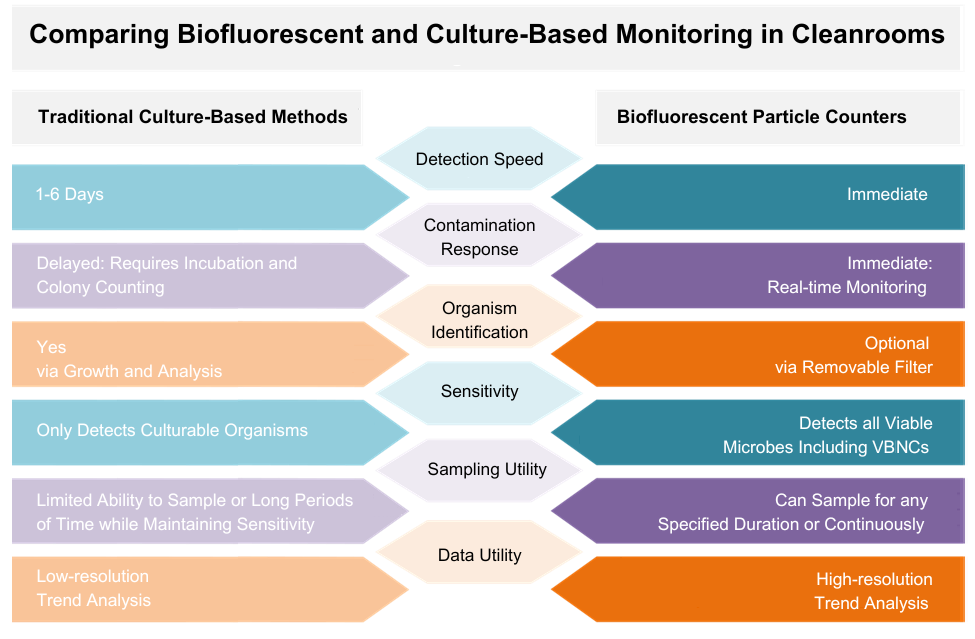Anzahl Durchsuchen:0 Autor:Christine Troutman – Director of Scientific Operations veröffentlichen Zeit: 2025-05-15 Herkunft:Powered
Environmental monitoring (EM) programs, specifically those that involve airborne microbial testing, in various industries are built around culture-based tools like active air samplers and settle plates. These methods are deeply embedded in industry practices and regulatory frameworks, and for good reason. They’re validated, widely accepted, and offer a clear path to identifying contamination and organisms of concern.
But they also have limitations.
Biofluorescent particle counters (BFPCs) offer a way to strengthen EM programs by filling critical gaps in timing, coverage, and responsiveness. BFPCs add real-time insight and elevate contamination control strategies. As the industry continues to move toward continuous monitoring and more data-driven decision-making, BFPCs are positioned to play a central role in the future of EM.
This article explores what BFPCs are, how they compare to culture-based methods, and where they offer the most value.

What Is a Biofluorescent Particle Counter?
A BFPC is an air monitoring instrument that continuously detects airborne particles and evaluates them for signs of biological origin. It does this by shining a laser on each particle and detecting whether it emits autofluorescence, a signal that naturally occurs in many microbial cells due to compounds like NADH and riboflavin.
Here's how the process typically works:
- Airflow: A steady stream of cleanroom air is drawn into the instrument at a defined rate.
- Laser Excitation: Each airborne particle passes through a laser beam.
- Fluorescence Analysis: If the particle fluoresces within specific wavelengths, it is flagged as "biological."
- Counting and Sizing: The system simultaneously sizes and counts every particle, fluorescent or non-fluorescent, and logs
it with a timestamp.

Some BFPCs, like the MicronView Remote BAMS, include a removable gelatin filter that collects airborne biological particles during sampling. This filter can be cultured if a spike in fluorescence is detected, allowing for species identification and aligning with GMP Annex 1 expectations.
Comparison: Culture-Based Methods vs. BFPCs
Feature | Settle Plates | Active Air Samplers | Biofluorescent Particle Counters |
Detection Principle | Passive collection on exposed agar | Active air pulled across agar | Laser-based autofluorescence of biological particles |
Detection Time | 1–6 days (incubation and colony counting required) | 1–6 days (incubation and colony counting required) | Instant |
Sampling Duration | 2–4 hours typical | 1–60 minutes typical | Continuous or set intervals |
Species Identification | Yes (via culture) | Yes (via culture) | Not direct, but possible with removable filter |
Data Frequency | Passive | Point-in-time | Continuous or point-in-time |
Labor Required | Medium | High | Low |
Contamination Alerts | No | No | Yes, in real time |
The Gaps in Traditional Culture-Based Monitoring
Culture-based methods are tried and true, but they come with limitations that reduce their effectiveness in fast-moving environments like isolators, cleanrooms, and compounding spaces. Here are some of the most common gaps:
1. Delayed Results
Both settle plates and air samplers rely on microbial growth. After collection, plates typically incubate for 3 to 7 days before results are available. This means any contamination that occurs today may not be known until a week later, long after the product has moved downstream or been released.
2. Limited Sampling Frequency
Due to labor demands, risk of cleanroom disruption, and procedural constraints, most facilities only run microbial sampling once or twice per shift. This leaves long windows of unmonitored time when contamination events may occur undetected.
3. Incomplete Environmental Visibility
A single active air sample represents a short window of time in a single location. Settle plates, while passive, only capture large settling particles and may not reflect the true airborne microbial burden, especially for fast-moving or transient contamination events.
4. Low Recovery Efficiency
Only a small fraction of airborne microorganisms will grow on standard agar media. Studies suggest that fewer than 10% of viable airborne microbes are culturable under standard conditions. That means many true contamination events might not result in colony formation, even if they pose a real risk.
5. Manual Process and Variability
Traditional EM methods require manual setup, incubation, counting, and documentation. Human error, technique differences, and inconsistencies in media exposure times can introduce variability that affects data integrity and trending.
BFPCs address many of these gaps directly, offering a real-time layer of monitoring that captures what culture-based methods often miss.
Looking Ahead: The Role of BFPCs in the Future of EM
Biofluorescent particle counters are here to elevate EM programs. They provide the real-time visibility that culture-based tools simply can’t offer, giving manufacturers faster insight into cleanroom conditions and enabling proactive responses before contamination becomes a costly issue.
As regulatory guidance continues to evolve, with increasing emphasis on continuous viable monitoring (as seen in Annex 1) and data-driven contamination control, BFPCs are becoming an essential tool in the modern EM toolkit.